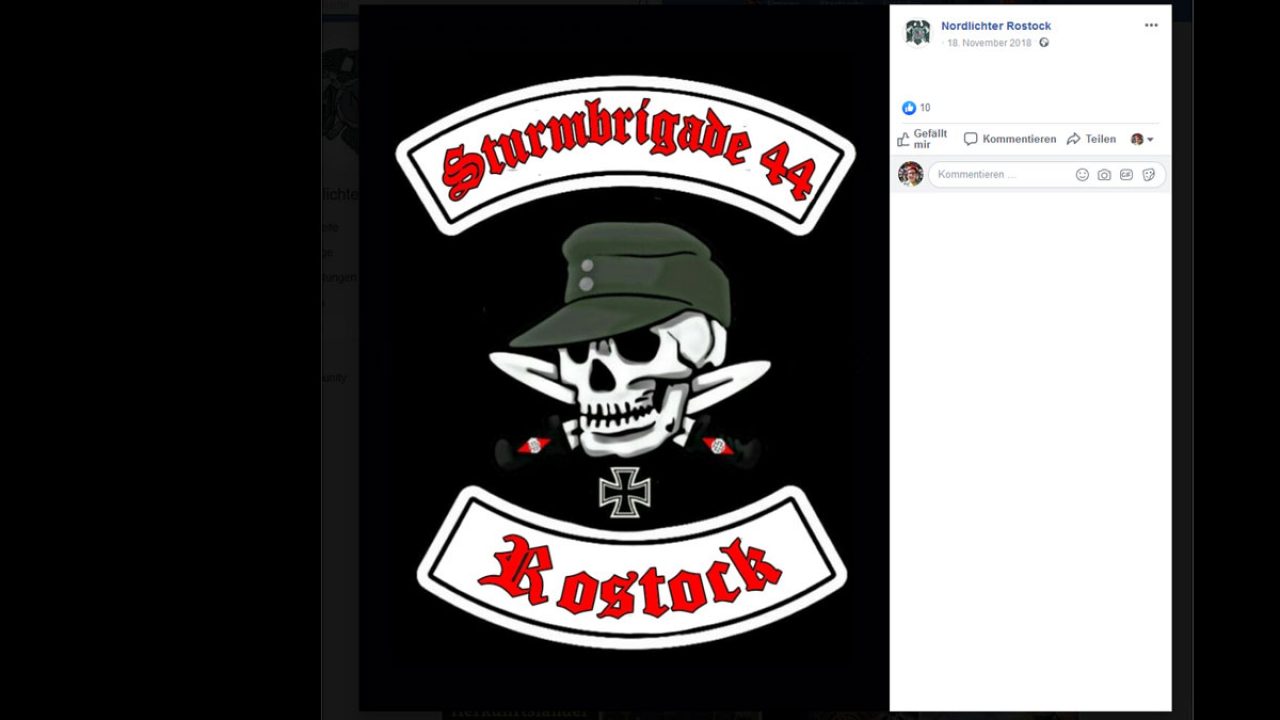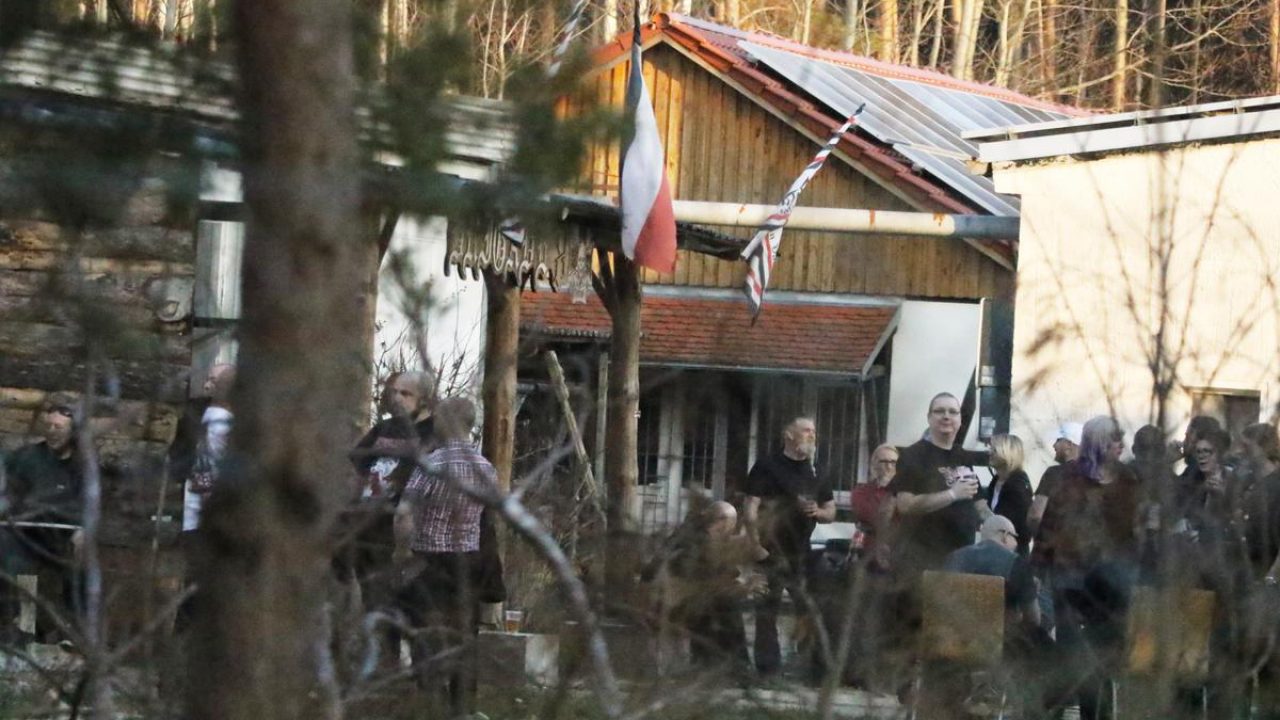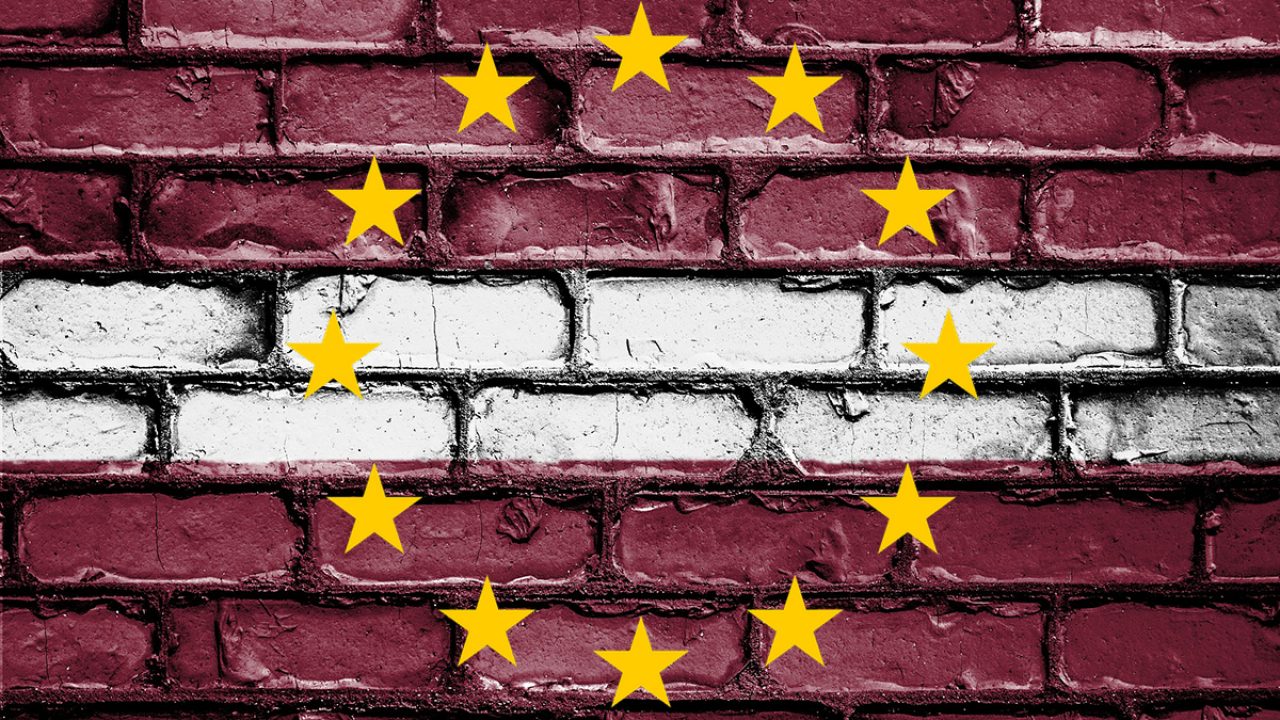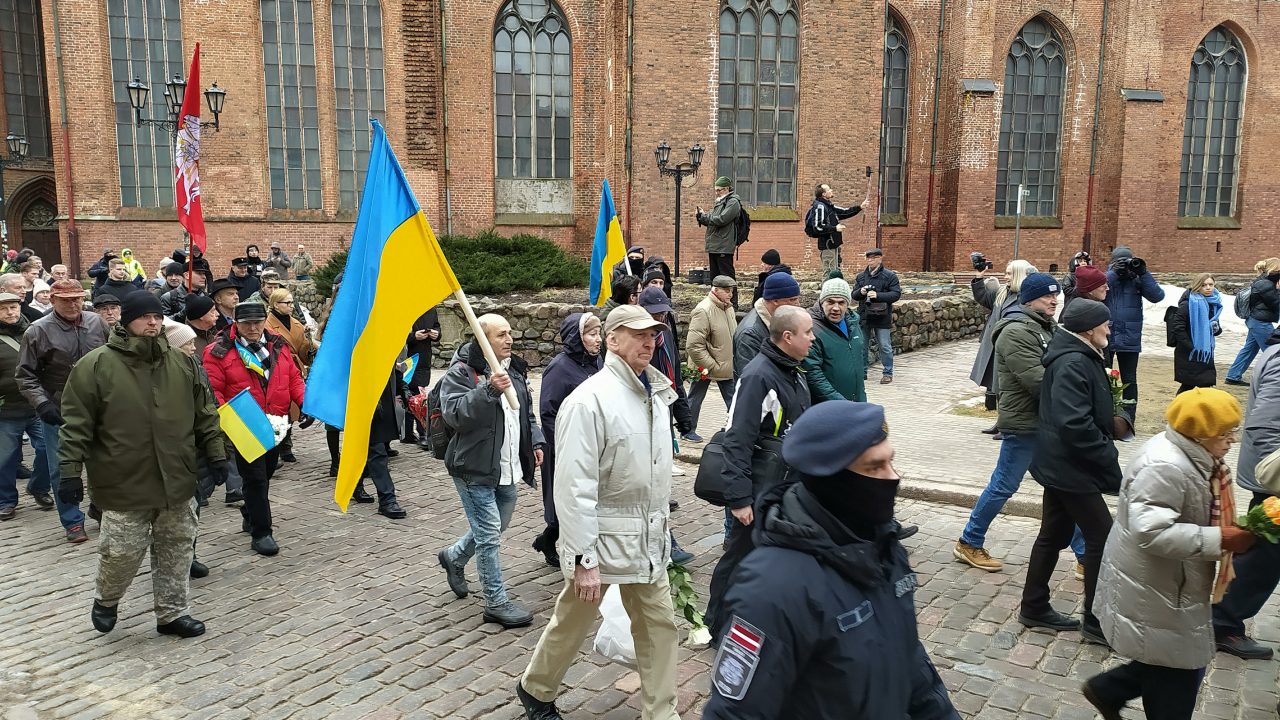
This text is an excerpt of the broschure „On Europe’s Streets – Annual Marches Glorifying Nazism“ by B’nai B’rith and Amadeu Antonio Foundation.
Name: Remembrance Day of the Latvian Legionnaires (Leģionāru piemiņas diena)
Location: Rīga, Latvia
Date: 16 March
Context, themes, slogans:
The Remembrance Day of the Latvian Legionnaires is held annually on 16 March in Rīga.[95] There
is no separate motto for the march, it is Legionnaires’ Day or just “16 March”, which is enough. The historical meaning of this day is widely known: On 16 March 1944, the Latvian Legion, the union of the 15th (Latvian No. 1) and 19th (Latvian No. 2) Waffen Grenadier Division of the SS fought together for
the first time in the same front area against the Red Army. With Latvian independence in 1991, 16 March became Legionnaires’ Day and annual marches began to be held.
The chronology of the commemoration is always the same. It begins with a memorial service at the Evangelical Lutheran cathedral in Rīga. Pastor Guntis Kalme gives a speech before leading the march. In this speech, he rails against counterdemonstrators and calls for a reassessment of World War II history in
which the Legionnaires are no longer “disparaged.” The march leads to the Freedom Monument in central Rīga, a 1930s monument honoring Latvian independence.
During the march, songs from a broad repertoire of Legion hymns are sung, including the Legion anthem Zem Mūsu Kājām (“Beneath our feet a white road leads to Latvia, where a ruthless enemy sows death in our fields. We are coming soon, Latvia, wait, we will bring you freedom”). This is the Latvian version of the anthem SS marschiert in Feindesland. Flowers and wreaths are laid at the memorial, as well as at the cemetery for Latvian Waffen-SS members in Lestenē, near Rīga.
Persistence:
The first march took place in 1990, and annual marches followed until 1998 with many official representatives of the state and army. In 2000, the Latvian government abolished Legionnaires’ Day as an official commemoration day.
Between 2004 and 2006, the march was banned, but other commemorations were held. Annual unofficial marches have continued since 2007, with interruptions due to the COVID-19 pandemic.
Organizers:
The march is organized by Daugava Accipiter (Daugavas Vanagi), the veterans’ association of former Latvian SS units, which was founded in Belgium in 1945 and is active in various countries. When in 2006 the official march was banned, the far-right National Power Union (Nacionālā Spēka Savienība/NSS) party and the ultra-nationalist Klubs 415 youth group organized marches and commemorations.
Number of participants:
The number of participants regularly ranges between 1,500 and 2,000.[99] Until the early 2000s, up to 200 Latvian Legion veterans took part, but almost all have since passed away. After cancellations due to the COVID-19 pandemic, the 2022 march was the smallest to date, with fewer than 200 participants.
Spectrum and topics of participants:
Regular participants include representatives of the right-wing populist National Alliance (Nacionālā apvienība/NA) party, a member of the current ruling coalition, such as Jānis Dombrava, Raivis Dzintars, Imants Parādnieks and Edvīns Šnore.
Representatives of the Lutheran Church also take part in the march, as well as families who want to commemorate their fallenancestors, pay homage to those who fought against the Soviets for a free Latvia, and at least pretend not to see the glorification of Nazi collaborators in the event.
Other regular participants include neo-Nazi Uldis Freimanis, who in 2011 called Jews “monkeys” on Latvian television and called for them to be shot, as well as neo-fascists from the now illegal Thunder Cross (Pērkonkrusts) organization founded by Igors Šiškins. In 1997, Šiškins and other Thunder Cross members attempted to blow up the Soviet-era Victory Monument in Rīga.
European networking:
Small delegations of ultra-nationalists from Estonia and Lithuania, Scandinavia, Germany, Poland,
Russia, and Ukraine have taken part in the marches, such as a delegation from the Ukrainian far-right National Corps party headed by Vladislav Kovalchuk in 2017.
Potential for violence/violent incidents:
No major violent incidents have beenrecorded.
Antisemitism and Holocaust denial
According to a widespread narrative in Latvia, the legionnaires were not only not involved in the persecution of Jews, they also only joined the Latvian Legion under duress, were mobilized by force and could therefore not be seen as collaborators. At the Nuremberg trials, the Latvian Legion was excluded
from the conviction of the SS as a criminal organization. German Einsatzgruppen, together with Latvian and Lithuanian auxiliaries, massacred most Latvian Jews. The Latvian Legion is not regarded as having been directly involved in the persecution of Latvia’s Jews, as this was simply not part of its area of responsibility.
By the Legion’s establishment in early 1943, nearly all of Latvia’s 90,000 Jews, as well as many tens of thousands of Jews in Belarus, had been murdered. Nevertheless, numerous members of the Latvian Legion took active part in the persecution of Jews in other capacities before the Legion’s establishment. In the case of the march, the fact that some legionnaires were recruited under duress should not be a reason to trivialize the crimes of National Socialism and to glorify the Latvian Legion. The fact that the participation of Latvians in the Shoah is downplayed or ignored amounts to Holocaust distortion.
At the march, swastikas are worn openly, SS anthems are sung, and the chevron of the Latvian Legion is featured prominently as a patch and in the form of wreaths. Participants occasionally deny the Holocaust or the fact that there are and were Jews in Latvia. At concerts aimed to appeal to a younger crowd taking place after the march in recent years, different neo-Nazi bands have performed, among them Diktatūra, whose repertoire includes a song called “Jews Out.”
Civil society response:
The march always takes place under police protection, which also serves to ward off counterdemonstrators. In the early years, former Jewish ghetto and concentration camp prisoners organized counterdemonstrations. Later, counterdemonstrators, partly from Latvia, but also from other European countries, protested the glorification of the SS. In 2016, the Latvian authorities imposed an entry ban on German anti-fascists. Some were not allowed to enter the country, while others were deported.
In recent years, mainly members of the Russian-speaking minority in Latvia protested the march. In 2023, however, a Russian-language protest would run the risk of being used as propaganda for Greater Russian interests. As part of its war of aggression on Ukraine and its imperial policy of violence, Russia instrumentalizes World War II and Holocaust history. According to Russian propaganda, “Nazis” have “seized power” not only in Ukraine, but also in the Baltic States.
Reaction by the authorities/bans:
Legionnaires’ Day is controversial in Latvian society. A march was first planned in 1989, which the Soviet authorities prevented at the time. On 16 March 1990, the first small processions took place. The day was an official national holiday until 1998 and politicians from various parties and high-ranking members of the army also took part in the march.
After public criticism, also in connection with Latvia’s 2004 accession to the European Union, the marches were banned in 2006 by a decision of the Rīga city administration, which was confirmed by an administrative court. The march resumed again in 2007, and in 2008 with the participation of mayor Janis Birkis. In 2010, the Latvian Supreme Court ruled that the ban imposed by the city administration was illegal.
In 2014, the Latvian government decided to ban ministers from participating in the march. The fact that the Minister for Environmental Protection and Regional Development, Einārs Cilinskis, flouted this
ban in the same year led to impeachment proceedings.
In 2022, the Victory Monument was dismantled alongside 68 other monuments, in accordance with the Law of 16 June 2022 on dismantling objects glorifying the Soviet or Nazi Regime. The law does, however, not contemplate dismantling sites where SS perpetrators are glorified, such as the afore–
mentioned Lestenē cemetery.
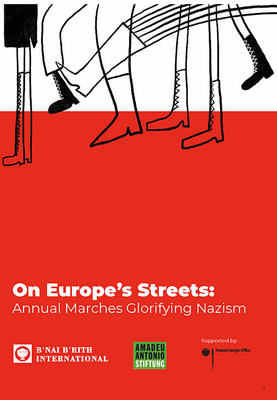
The report is now available to download (in English):
https://www.amadeu-antonio-stiftung.de/publikationen/on-europes-streets/
Excerpts from the report on Belltower.News will follow!
Part 1: The Marches
1. Day of Honor, Hungary
2. Memorial March for the Bombing of Dresden, Germany
3. Lukov March, Bulgaria
4. Blue Division March, Spain
5. Remembrance Day of the Latvian Legionnaires
6. Bleiburg Meeting, Austria
7. Rudolf Hess Memorial March, Germany
8. Iron Wake, Belgium
9. March on Rome, Italy
10. Independence March, Poland
11. Kohti vapautta and 612-march, Finland
12. Imia March, Greece
Conclusion to Part I: The danger of the marches
Part 2- Legal Analysis
